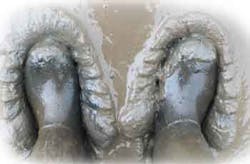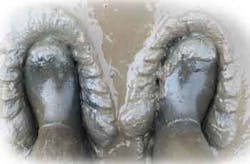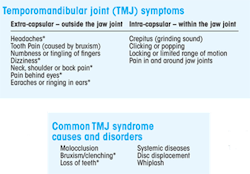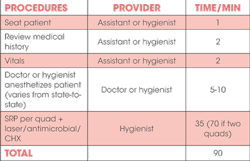Living with Parkinson’s and looking for relief
Hygienist applies her skills to cope with disease beyond pills
by CARLA GANTZ, RDH
It was Tuesday, May 9, 2006, when I heard the words "You have Parkinson's disease" (PD) with my husband by my side. My first thought was not being able to retire at the lake house as planned. The doctor's voice immediately became muffled to me. Like Pink Floyd's lyrics, "Your lips move but I can't hear what you're saying," and I was going numb.
Unexpectedly, a small voice from deep within me spoke to me, telling me to listen to the doctor; this is serious! The doctor's voice quit its background droning as I slowly crossed back to existence and paid attention to him.
He was saying that my PD is unilateral, located only on my right side, hand, arm, and shoulder, which placed me in stage 1 PD. My first medication was Requip, which was fantastic for my tremor, but wreaked havoc with my stomach. So I started taking carbidopa/levodopa 25/100 three times a day. Knowing PD is a neurodegenerative brain disorder that progresses slowly, I clung to the word "slowly." In April 2008, my prescription was changed to ER (extended release) 50/200 and increased to four times a day.
Little by little, PD interfered with my role as a dental hygienist. The first thing I clinically gave up was local anesthesia. Next, my manual dexterity for flipping instruments in my hand became awkward, and some days I was just downright klutzy. Later, while polishing or scaling, my hand would come to a halt as if it were glued to the tooth. This is known as freezing, a secondary motor symptom of PD.
My only way to break a freeze, unbeknownst to a patient, was to bring my left arm around to lift up my right arm, which allowed me to pull my hand out of the mouth and try again. For the most part, this worked for me, but I soon learned there were no tricks for a tremor. For five years, carbidopa/levodopa regulated my tremor in my right hand, which allowed me to work in clinical hygiene, as treatment plan coordinator, and office manager, and even play the piano for church services.
But in 2011, reality happened, and my tremor reached the point of unpredictability. My piano playing and my dental hygiene career were over. As my symptoms increased, so did my medication. My total was up to 13 pills a day. It was time for me to look beyond just pills for help.
The major problem with levodopa is that after four to six years of treatment, about 40% of patients develop motor fluctuations and dyskinesias.1 Even though there was a 60% chance I would not develop these side effects, it was still not the comfort level I desired. There had to be something else. PD had taken away my career and forced me to swallow 13 pills a day, and it just didn't seem right.
About a year ago, a friend forwarded me a newsletter from the Parkinson's Resource Organization at www.parkinsonresource.org. I recall briefly reading the newsletter and filing it in my PD file. Looking at the newsletter again later, I found myself amazed, reading article after article about temporomandibular joint dysfunctions (TMJD) and PD. The articles talked about how there is increasing evidence that people diagnosed with PD are likely to have TMJD, and proper treatment of this disorder by a qualified dentist can help alleviate the symptoms of the disease.2
How could this be? PD is a neurological disease that affects the substantia nigra's ability to produce dopamine. Dopamine is a neurotransmitter that helps cells transmit signals between one another, plus it is the key to keeping one's balance, controlling one's movement, and making sure that muscles work smoothly. As a dental hygienist, I didn't see the connection. Could some of my PD symptoms be TMJD? Could this work for me? The article stressed that this is not a cure for PD and there are no pills to swallow. I placed a call to my former employer, Dr. William H. Funk, who has been successfully treating temporomandibular disorder for over 30 years. Like me, he was unaware of such treatment but very supportive, and he agreed to read the article and get back in touch with me.
Still overwhelmed by this phenomenon, I started researching, and I began by reviewing the temporomandibular joint (TMJ) system. What are the symptoms? What causes the symptoms? TMJ is considered the most complex joint in the body because it moves in multiple directions. The mandible is connected to the skull by the TMJ, with discs between them.3 It is a ginglymo-arthrodial joint. A ginglymus joint is a hinge joint, and an arthrodia joint is a gliding joint. The TMJ is the only joint that both hinges and glides.4
These discs are made of fibrocartilage and play an important role in maintaining good health. These discs not only keep the jawbone from coming into contact with the skull, they keep the jawbone from impinging on the large number of nerves and blood vessels running behind the joint and in front of the ear.5 When the jaw is misaligned, or if the space behind the condyle is lost through anterior displacement of the disc, the condyle will move backward and pinch the nerve tissue, causing inflammation or insult.6 This affects all aspects of the sensory, proprioceptive, and motor reflexes, creating a broad array of medical disorders.7
The trigeminal nerve V is a complex and powerful nerve, and when insulted its systems are directly altered. A branch of the trigeminal system, the auriculotemporal nerve, passes through the jaw joint behind the small joint disc.8-9 This nerve is unusual because it has both motor and sensory capabilities. When the trigeminal nerve is affected, it can cause symptoms such as dizziness and vertigo,10 ear pain,11, 12 sensory and motor skills alterations, and imbalance.13
I continued my research. I found a paper written over 30 years ago called "The Dental Distress Syndrome" by Dr. A.C. Fonder, which described the effects of malocclusion, referred to as the "bad bite," as it relates to general health, and how it affected the entire body and all of its systems. With occlusal (relating to the biting surface of a molar or premolar tooth) correction, Dr. Fonder was able to eliminate 80% to 100% of all symptoms of Parkinson's, epilepsy, CNS problems, headaches, sinusitis/respiratory problems, bad posture, GI problems, and gynecological problems.
His results were presented at several international congresses. Another article, "PD: Are some cases misdiagnosed craniomandibular dysfunction?" by Dwight Jennings, DDS, outlines how craniomandibular dysfunction can cause many symptoms attributed to PD. I asked myself again, "Could some of my symptoms be coming from TMJ?" Yes, I believe so. Reviewing the symptoms for TMJ, I have five out of seven symptoms! Since the early 1980s I've suffered from vertigo, dizziness, and ear pain. In February this year I was referred to an ENT for otitis media. I spent countless days with pain behind my eyes, not to mention numerous headaches, and I was blaming the Kentucky weather.
I presumed my neck and shoulder pain was due to PD, since I started PD with a frozen shoulder. This was unbelievable news! Here I was a dental hygienist and I did not recognize these symptoms. I created the charts appearing with this article, and I matched the symptoms to the PD category with the two articles mentioned here and highlighted with asterisks my symptoms. The chart shows more incredible findings.
Dr. Funk called me after he read the article and after he had done his own research. He learned that Dr. Brendan Stack of Vienna, Va., was the first to recognize this phenomenon about 20 years ago. Dr. Stack's focus has been on the treatment of patients with movement disorders, whether due to PD, cervical dystonia, Tourette's syndrome, or torticollis. He has been very successful in this area, particularly in eliminating the tremors and involuntary muscle movements of Parkinson's patients.
Dr. Funk called Dr. Stack and arranged to shadow him for a day. Dr. Funk was amazed to learn that the control of this jaw joint-related problem was very different than what he had been doing for 30 years. On April 19, Dr. Funk seated my acrylic mandibular repositioning appliance (MRA). This appliance will separate my condyle from the articular eminence, stopping the auriculotemporal nerve insult and thus allowing the nerve to return to normal function.
In retrospect, the times that I catch myself in a hunched position, my body becomes somewhat rigid. While walking, my right arm has less range of motion. During the last 18 months, I've suffered with pain in my right leg. This is not in a muscle or joint, but at the middle front of my thigh just above my knee. Some nights the pain is so excruciating that lying down is not an option. The only relief comes from walking, and several nights and early mornings I can be found walking circles around our kitchen bar.
My results with the MRA have been fantastic! My pain is gone. I'm sleeping all night, which improves my fatigue. My tremors are 80% less. My dexterity has not returned, which makes typing, operating the mouse, and writing very challenging. Compliance can be an issue if it's not worn 24/7, including while eating. My pain slowly returns, along with an increase in tremors. I now keep a journal, and today is my 166th day with my MRA. I do not believe the MRA has cured my PD; however, I've been able to reduce my medication Comtan to 200mg. My daily pill count now is seven, and my plans are to continue looking for treatment "beyond pills."
For more information on finding a dentist in your area, go to http://parkinsonsresource.org. RDH
References
1. Ahlskog JE, Muenter MD. Frequency of levodopa related dyskinesias and motor fluctuations as estimated from the cumulative literature. Mov Disord 2001; 16:448–458.
2. Lauson, Kent S.; Grove, David T.; copyright 2012 Pg. 305-306 Straight Talk About Crooked Teeth
3. Ahlskog JE, Muenter MD. Frequency of levodopa related dyskinesias and motor fluctuations as estimated from the cumulative literature. Mov Disord 2001; 16:448–458.
4. Lauson, Kent S.; Grove, David T.; copyright 2012 Pg. 305-306 Straight Talk About Crooked Teeth
5. Richard,Patricia A Craniofacial Pain & temporomandibular Joint Disorders Pg. 2; copyright 2007
6. Wooten, David Rolfe; TMJ Dysfunction , an Ounce of Prevention ; PRO Newsletter, July 2011
7. Leonard Feld, The Jaw Bone's Connected to the Whole Body
8. Leonard J Feld The Pain Practitioner Volume 20, Number 2- Summer 2010 Temporomandibular Disorder: The Great Imposter
9. Jennings, Dwight Journal American Academy of Craniofacial Pain. Vol 21 #1 April 2008 Pg.28-33 "Parkinson's Disease: Are some cases misdiagnosed- Craniomandibular dysfunction?"
10. Johansson A-S, Isacsson G,Isberg A,Granholm A-C: Scand J Dent Res 1986
11. Johansson A-S, Isacsson G,Isberg A: J Oral Maxillofac Surg 1990
12. Buisseret-Delmas C,Compoint C,Delfini C,Buisseret P:J Comp Neurol. 1999
13. Costen JB: ann Otol Rhin Laryngol 1934
14. Costen JB: J Kansas M Soc 1935
15. Warner TF, Tomic S, Chang CK: J Reprod Med. 1996
Carla Gantz, RDH, has a combination of 30 years of experience as a dental assistant, clinical hygienist, treatment coordinator, and business/office manager. She is a HygieneFusion consultant, 2012 Sunstar Award of Distinction recipient, an author, speaker, and webinar presenter. A graduate of the Western Kentucky University Dental Hygiene Program, she is a member of the American Dental Hygienists' Association, CAREERfusion, and the American Academy of Dental Hygiene. She can be contacted at [email protected].
Consider reading: 2012 Sunstar/RDH Award of Distinction
http://www.rdhmag.com/articles/print/volume-32/issue-9/features/2012-award-of-distinction.html
Consider reading: Benefits of periodontal trays
http://www.rdhmag.com/articles/print/volume-32/issue-11/features/sink-teeth-into-them.html
Consider reading: A personal perspective of Parkinson's disease
http://www.rdhmag.com/articles/print/volume-31/issue-10/columns/a-personal-perspective-of-parkinsons-disease.html
Past RDH Issues



